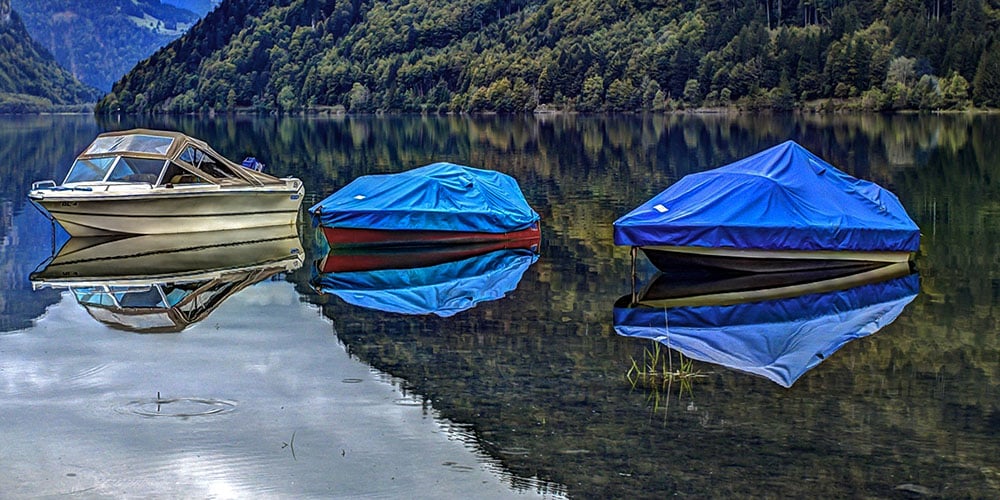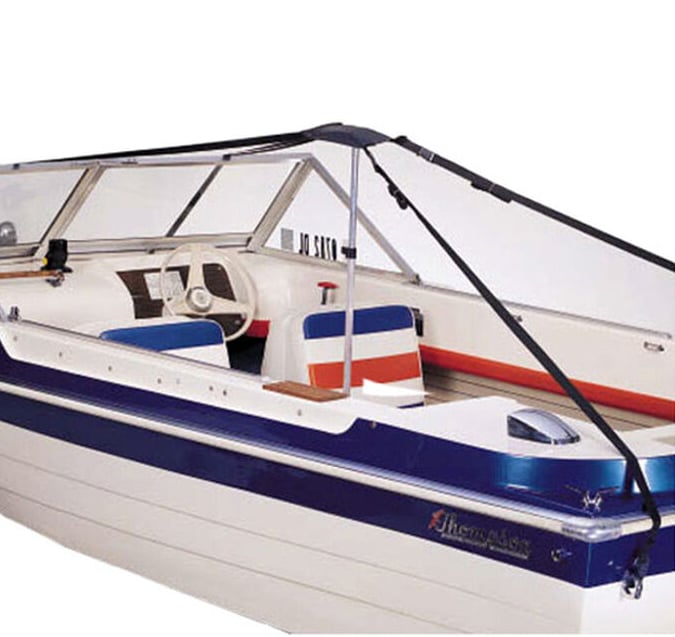
Every day, most boats endure a cycle of temperature and humidity changes, from cool and damp nights to hot, dry bright sun. This expansion and contraction, wet-dry daily cycling, occurring even on days with the best boating weather, takes a toll on gelcoat and wood brightwork. Add salt air, pollution, dirt, rodents, bird droppings, the occasional hailstorm and who knows what else, and your expensive, prized possession is under siege. That’s why a good boat cover is so important. A modest investment in a cover prevents faded and oxidized gelcoat, bleached and cracked wood, mildew and mold. It also hides valuable equipment from theft, because what’s out of sight is out of mind. We'll walk you through everything you need to consider to pock the right one for your boat.
- What Type of Boat Cover
- Types of Boat Cover Fabrics
- How to Measure a Boat Cover
- Snug it Down and Keep it Clean
What Type of Cover Do You Want?
Storage vs. trailering: Storage covers are designed to fit loosely and are best used for protecting boats at anchor, at the dock or when stored on the trailer. They range from a simple blue tarp to a framed canopy (essentially a portable garage made from metal tubing and fabric) or a mast-up mooring cover for a sailboat. On the other hand, covers for boats that are trailered, must have a snug fit and reinforcement in high-wear areas to withstand the rigors of traveling at highway speeds.
Semi-custom Covers for a Better Fit
Semi-custom covers are designed to fit several makes and models of boats with the same hull style. If you own a bass boat, the same model fits a Crestliner, Lund, Alumacraft or Starcraft. One size fits your Mastercraft or Correctcraft competition ski boat. A more forgiving liberal fit accommodates size variations.
Types of Boat Cover Fabrics
Fabric properties: Boat cover fabrics need to be the right combination of breathability and water repellency—to keep rain water out, yet allow trapped water vapor to escape. They also need to be UV- and mildew-resistant. Tensile strength and abrasion resistance is especially important in trailer covers as they withstand the rigors of the road. Few materials perfectly meet all the requirements, but coated synthetic fabrics come pretty close to the ideal compromise. Cotton and polyester blends won't last as long as synthetic fabrics, as natural yarns simply don't have high resistance against mildew and UV light. Pigment dyed polyester fabrics have a good strength to weight ratio and are an excellent choice because it is strong and breathable, yet it repels water and stands up to UV radiation. A good yet economical choice when choosing a synthetic fabric is Hot Shot™, an acrylic coated polyester.
Taylor Made® Semi-Custom Boat Covers
West Marine currently offers Taylor Made Semi-Custom covers in six different colors for 21 different styles of boats. Examples include covers made for Whaler style inshore fishing boats, bass boats, center console boats, bay boats and other styles of boats. Compared to loose fitting “universal boat covers”, these covers offer a tighter fit, which makes them a far better choice for trailering your boat.
Features of Taylor Made Semi-Custom Covers include sewn in tie-down loops, double-folded hems, an integrated shock-cord and 4-ply seams. All are made of Hot Shot™ fabric, which is a 6 ounce, acrylic-coated polyester that offers good breathability, great strength and water, mildew and UV resistance—which makes it a good choice for hot or humid climates. Seams are sewn with Gore® Tenara® thread, which will not stain, mold, mildew or discolor and will outlast the material it is sewn into.
If you own a traditionally built wood boat, Hot Shot™ fabric is a good choice, but to help control wood's expansion and contraction, owners may want to also install extra vents in their covers, such as the Taylor Boat Vent II (Model 5378575).

What Color Do You Want?
Colors and dye: We recommend dark colors, which at first may sound surprising. But the higher amount of dye in dark materials increases a fabric’s UV resistance and contributes to its longevity. Blue, black and green last longer than white, tan or red. Of course, darker colors also absorb more heat, and transmit it to whatever is under them.
Carver Universal Fit Flex-Fit™ PRO Boat Covers
In addition to semi-custom and custom boat covers by Taylor Made Products, West Marine now offers Carver Universal Fit Flex-Fit PRO Boat Covers. These economically-priced boat covers are an excellent choice for mooring, trailering, or storage. They are made of Carver's solution-dyed, Poly-Flex II, 5.3-ounce material with a 3/4-ounce urethane coating. These covers also feature a durable, water-repellent, mildew-resistant finish. Carver's Flex-Fit Pro Covers are the only domestically-produced universal boat covers cut and sewn in the USA.

How to Measure a Boat Cover
To buy the right cover from West Marine, match up your boat as closely as possible to the hull style pictures in our catalog or on our web site. Next, take a tape measure to determine the beam width, the widest distance across the boat in a flat line. Repeat the same process to determine the centerline length, the overall length of the boat measured in a flat line between the farthest points forward and aft you want to have covered. Allow for options like bow pulpits, swim platforms, etc., but don’t measure over them—keep a flat, straight line. Covers are offered in one-foot length increments.

Boat cover support systems elevate your cover to keep water, leaves and other debris from collapsing it.
Avoid Common Mistakes
Make sure you include all the equipment you want to cover in your measurements. If the cover is too big it will sag under the weight of rainwater, which collects in the low spots. Oversized covers also billow in windy conditions, increasing the risk of snagging and tearing on sharp objects. If the fit is too tight, seams and fabric are subject to disproportionate stretching, which also leads to damage. Sometimes we see boats being towed on the freeway with their storage covers wildly flapping in the breeze. This practice is unsafe, reducing the driver’s visibility to the rear and endangering others. For safety’s sake, please use enough tiedowns or remove storage covers altogether if you take public roads and travel at high speeds.
Snug it Down and Keep it Clean
The snugness of the cover is the single most important factor for insuring a trouble-free boat cover life. Each and every tiedown loop must be securely tied to the boat or trailer using rope, shock cord, or straps. Note: If tying off to your trailer, the boat must also be rigidly fastened to the trailer. Before tightening, the cover must be properly supported and padded. Protect the sides of your boat from hooks or buckles that may scratch the finish.
If using shock cord, be sure it is heavy enough so the cover does not billow when trailering. Fabric straps must be resistant to sunlight and exposure. Be careful using ratchet-type tighteners. They can place undue stress on the cover and shorten its useful life.
Wash your cover with mild soap or detergent. Shake out dust, use a garden hose to rinse off dirt, or use compressed air for stubborn dirt. Do not use a scrub brush, put into the washer or dryer, use bleach or harsh astringents. Line dry.